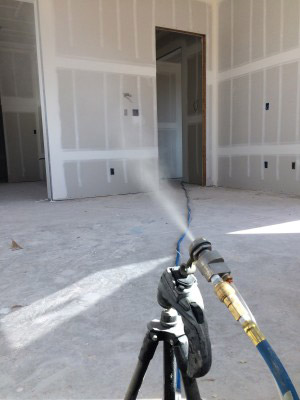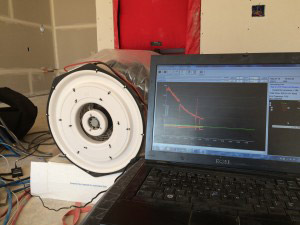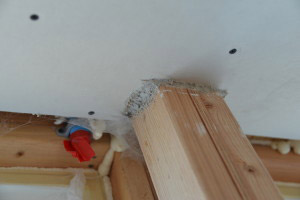Sealing and insulating a home's building envelope can be an expensive and time-consuming process, and can often be susceptible to human error. Currently, contractors need to manually locate small and large gaps in a building's structure in order to completely seal the space from air and water, but they can often miss holes or not even know they exist in the first place, such as those in electrical outlets.
A new technology from duct-sealing company Aeroseal seeks to eliminate some of the problems and shortcomings of traditional insulation with an automated aerosolized sealing system that is more efficient and precise than others on the market.

The Aerobarrier system uses an aerosol-applied sealant that creates an air barrier around ceilings, walls, floors, doors, windows, and electrical and plumbing fixtures.
To use AeroBarrier, workers need to temporarily block windows, doors, electrical outlets, and any other spaces that they don't want sealed. Then, after pressurizing the room and setting the system to seal to a specific tightness (for example, the Passive House Standard is 0.6 ACH), the automatic system sprays sealant particles that travel to openings and build up and bond together to seal holes. The company says the technology can seal gaps up to 1/2” wide and as small as a human hair. After the sealant is applied, it looks like a gray caulk and can be painted over.
The product isn't on the market yet, but the company has used it to seal numerous multifamily buildings and has partnered with several production builders for field trials on new single-family homes. Here, BUILDER talks with Amit Gupta, CEO of Aeroseal, about the new AeroBarrier technology:
Please tell us a bit about AeroBarrier and how it works.
AeroBarrier is a single-step aerosolized sealing process that simultaneously measures and seals building envelope leaks. The technological concepts used with AeroBarrier are an extension of aerosol-based duct sealing technology developed by the Department of Energy in the late 1990s.
What are its advantages, and how is it different from existing sealants on the market?

The computerized Aerobarrier system provides real-time analysis of the sealing process for documented results.
Effectively sealing a building envelope is currently a manual multi-step, multi-product process that typically requires application and verification during various stages of construction. AeroBarrier replaces these various procedures with a single-step, single application computer-controlled process that simultaneously seals and verifies the tightness of the building envelope. AeroBarrier can also be used in addition to current sealing processes as a means of meeting specifications when traditional methods fail.
Some of its key benefits include; meeting the most aggressive air leakage standards, only taking about 2-3 hours to seal a room including set up, and cutting down on the manual process in a single-step, single product application. The technology also provides a final report with documented results.
What types of products and laborers could this technology replace in the future?
Today, effectively sealing the building envelope requires an assortment of products used during various stages of the building process. These may include insulation, spray foams, wraps, caulking, barrier sheeting and mastics among others. AeroBarrier can replace most, if not all of these sealing strategies with a single application.
In addition, traditional manual sealing is accomplished via numerous workers during various stages of the building process, while AeroBarrier typically requires only two to three workers applying the sealant during a single phase of construction. Some contractors may use AeroBarrier as a replacement for some or all of these current methods, while others may apply the technology as a means of meeting specifications when traditional methods have failed.

The Aerobarrier sealant does not coat entire surface areas but rather affixes itself primarily in and around the envelope leaks themselves.
How much will it cost and how much can it save a builder?
As of right now, we are still working on determining the cost. Different builders currently use different methods to achieve adequate envelope tightness, so the savings depend upon a number of variables including current methods and processes used. We hope to have a better understanding of this – as well as how much it will cost to apply the sealant- as the technology is introduced into the marketplace and we work with more builders.
What were some challenges with bringing it to market?
As with the introduction of any groundbreaking innovation, there are issues related to educating and proving viability. During this pre-market phase, Aeroseal worked hard to gain the trust of our contractor partners and answer questions they may have had regarding the technology’s application, efficacy, durability, and viability on the job. During development, there were also ongoing tweaks made to both the sealant properties and the delivery equipment to ensure maximum effectiveness and its conducive application in real-world environment. As we get closer to market introduction, questions regarding cost savings and price point are being examined.
When do you anticipate it will be available?
AeroBarrier is currently being used in final field trials and is expected to be commercially available in early 2018.


Service Hotline
Work Time:Mon-Fri 9:00-18:00
UTC+8

Sinoexpo Digital Platform
Copyright 2006-2025 Shanghai Sinoexpo Informa Markets International Exhibition Co., Ltd. All rights reserved
沪ICP备05034851号-77
 沪公网安备 31010402000543号
沪公网安备 31010402000543号